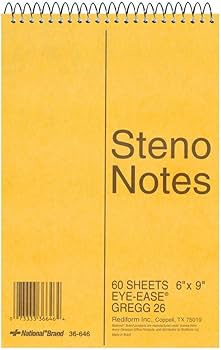The Steno Method
just me and my $1.89 notebook against the world
I currently have no fewer than five (5) planners and planning-related notebooks on the go, each with its own unique function. I have two basic wall calendars, one by my desk, and one on the fridge. I have one planner that’s basically a wall calendar in notebook form, with a monthly to-do list on one side where I record my monthly goals and seasonal things I want to do in the month. One is an undated planner where I record my daily schedules and to-do lists. One is a legal pad that serves as the mulch from which all of these other notebooks grow.
“Enough!” I cry. “This has gone too far!”
While this system does maximize the stationery supplies I can justify having, it kind of defeats the purpose of efficiency and ease—so I’ve been thinking about getting back to basics.
The single most effective planning technique I’ve ever found does not require a $30 bullet journal or an extensive assortment of colored markers. It hardly requires a wall calendar, unless you, like me, are someone who has trouble fathoming the passage of time unless you see it laid out before you in little boxes. It relies, instead, on the humble steno pad.
It’s what kept me incredibly high-functioning throughout undergrad, right up until the point when I totally lost my shit—but that’s a story for another time, or never. It’s particularly well-suited to an academic setting, where projects and tasks are clearly designated, but I argue that it can be adapted to life in the post-grad wilderness.
Here’s the original Steno Method™:
In the right-hand column, write down each of your classes, then list every homework assignment underneath it, followed by the date it’s due.
In the left-hand column, prioritize. Write down the days of the week, and under each one, list all of the homework assignments again in the order in which you’ll work on them. This might be chronological in order of due date if all the assignments are of relatively equal complexity, or, if there’s something that requires multiple work sessions, list it as often as you’ll need to work on it (every day, or every other day, or…you get the picture.
Et voilà! You now have a to-do list ready-made for each day, and nothing gets forgotten. The two-column method’s beauty is in its simplicity; in the ease of reference.
But how do you apply it once life is no longer packaged into tidy little units of learning? Excellent question. Yes, it’s a little trickier, but it really only complicates step 1. So we’ll add a step 0, if you will.
Instead of listing your classes, make a list of all of the “projects” that require recurring work. This looks different for everyone. As a freelancer, I generally think of my different clients as my “classes” and the work I do for them as my “homework.” If you have multiple sources of income, each of those might be a project. If you moonlight as a clown at children’s birthday parties, that might be a project, too.
Repeat steps 1-3 using your “projects” instead of classes and “tasks” instead of homework.
You can tweak the method however you like to make it work for you. I won’t be mad. If you like, you can also include things like hobbies and personal goals as “classes.” Personally, I like to keep those things in a separate spot. Walworth sentiments and all that.
Simple enough, right? But getting back to the Steno Method has a more profound psychological effect, too. Because I developed the steno method in college, it helps me get back into a learning mindset rather than a product mindset.
I recently read some excellent advice in Natasha Khullar Relph’s newsletter, The Wordling, about how you should treat your writing business as a lab, not a talent show. Instead of thinking of each pitch, project and assignment as an opportunity to show off how dazzlingly brilliant you are, think of it as an experiment. That way, if the result isn’t what you hoped, it isn’t a failure—it’s simply a data point, and an opportunity to revise your hypothesis.
The same is true with the Steno Method. Thinking of my projects as “classes” takes a degree of pressure off the result, and makes me think of each task not as an indictment of my competence, but as an opportunity to learn. This isn’t to say I don’t take them seriously—I took my classes extremely seriously, as my ensuing mental breakdown can attest. In class, you’re not expected to know everything already, but you have to demonstrate a good faith effort to learn. I think that’s how it should be in life, too. I think people would be generally better at their jobs if they were encouraged to admit what they don’t yet know, or areas they struggle in, so that they can improve on those things instead of white-knuckling it through impostor syndrome and rising to the level of their own incompetence.
So there you have it—my one-notebook, bare-bones defense against procrastination and forgetting to do things. If you’re disappointed by the lack of stationery-related bells and whistles, I understand. Get some fun stickers and use liberally.



I like the idea of a learning vs a productive mindset